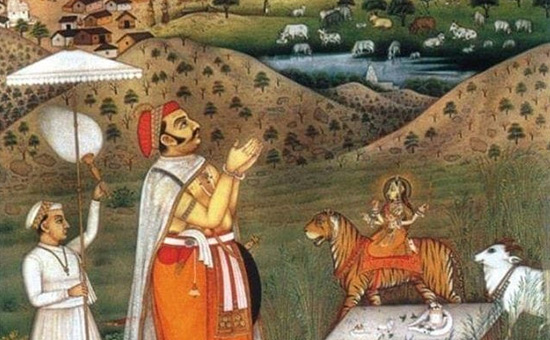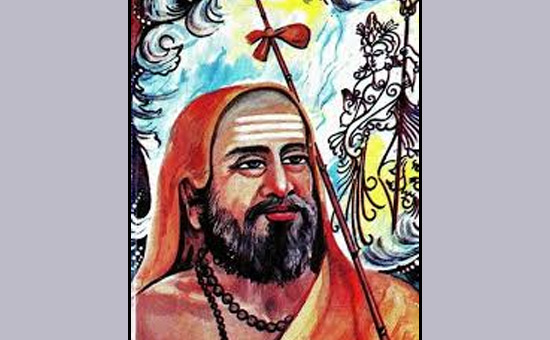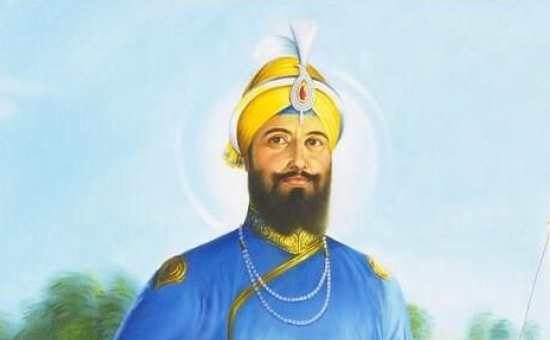- This article
tells what history books rarely teach in terms of Hindu resistance, counter
attack and role of sages in the fightback.
Part One
was Hindu resistance to Islamic conquest of Sindh, Punjab and Kabul. Part Two
is about the Battle of Bahraich where Hindus defeated Muslims. Part Three
is about the Rajputs won and lost. Part Four gives examples of Hindu kings who fought back Muslim invasions.
India, whose people invented iron & steel, who first laid down
concept of moral conscience, who fought heroic wars but did not permit their
kshatriya warriors to smear the tip of their arrows with poison, whose most
striking feature is humanity, the great temple builders who lost
millions of their people to forced religious conversions, did not perish
inspite of suffering sustained attacks from Islam since the 7th century.
Instead they continue to be a vibrant religious and cultural force to this day.
This is what Lieutenant Colonel James Tod (1782-1835) wrote in
Annals and Antiquities of Rajasthan:
“What nation on earth could have maintained
the semblance of civilization, the spirit or the customs of their forefathers,
during so many centuries of overwhelming depression..…. Rajasthan exhibits the
sole example in the history of mankind, of a people withstanding every outrage
barbarity could inflict, or human nature sustain...... not an iota of their
religion or customs have they lost…”.
After an unsuccessful campaign of about eighty years, though
Muhammad-bin-Qasim was successful in capturing Sindh in 712 A.D, it took him
eight months to acquire control over Sindh due to the tough resistance by the
people of many towns including Alor and Brahmanabad.
Unlike the popular belief that Hindus offered practically no resistance
to Islamic aggression, there arose from time to time, heroic men and women who
fought with counter- aggression making it impossible for Muslims to bring the entire
Hindu society under their green flag.
The Hindus not only inflicted political defeats on the Muslims but
kings like Bhima, Rana Pratap etc and kings of Vijayanagar crippled and
rendered them out of gear. With deadly blows, the Marathas fluttered their flag
right up to Attock.
सर्वे धर्मों प्रक्षेययूर्विरद्धा:
क्षात्रे त्यकते राजधर्मे पुराणे।
In the event of the
Kshatriyas forsaking their kingly duty all the religions are bound to
perish.
And that is what exactly happened to the Kshatriyas who had chosen to follow the path of ahimsa. Sri Aurobindo said, “Every ascetic movement since the time of the Buddha has left India weaker and for an obvious reason.”
When Dahir fell and Qasim captured Port Deval,
Buddhists rang the bells in vihars and to greet him and prayed for his
prosperity…perhaps they thought that the new aggressors might embrace their
cult too? However, Bin Qasim
beheaded the Buddhists more ruthlessly than the Hindus.
"We have nothing to do with Dahir and his Vedic Hindu cult, our religious faith differs from theirs. Buddha taught us Ahimsa so we never take arms and never dabble in politics. Since you are the victor, you are our king, we pray that we should not be subjected to any indignities.” Source Veer Savarkar, Six glorious epochs of
Indian History, 326A, page117.
Muslim writers of Tarikhs mention, “Buddhist in Sindh helped the Muslims
in every possible way, while the latter marched onwards, by showing them
difficult passes, providing them with foodstuff and fodder and supplying them
secret military intelligence.”
Qasim assured the Buddhists of safety…but went on beheading them
ruthlessly since there was no armed opposition in Buddhist Vihars, the Hindus
were fighting in groups or individually. Buddhist Vihars throughout Sindh were
knocked down, only those were spared who accepted Islam.
 Bappa Rawal of Mewar attacked and annexed Muslim strongholds in Sindh.
Bappa Rawal of Mewar attacked and annexed Muslim strongholds in Sindh.
From the Sultans to the common soldiers, all
began to settle down in Bharatvarsha with at least three or four forcibly
polluted Hindu women each in their harems. Considered kafirs and slaves, Hindu
girls were often enticed, carried away by Muslim women who considered it their
holy duty to convey them to Masjids and Muslim centres. Be it a begum or a
popper, no Muslim women ever protested against the atrocities committed
by their men on Hindu women, on the contrary they played devilish roles by
doing whatever possible in their power to harass the captured Hindu girls.
The Hindu Kings in those times were chivalrous
towards enemy women, who feared no retribution or punishment at their hands for
their heinous crimes. But the Hindus of the Pre-Islamic Era never extended chivalry to men/ women
who deserved nothing but the most stringent punishment for their atrocious
crimes. They knew very well that ahimsa is the highest virtue, the highest self-control,
highest sacrifice, finest strength, greatest truth & happiness, but they
also knew that -
Non-violence is
the ultimate duty but the path of Violence has to be taken for protection of
Dharma.
अहिंसा परमो धर्मः धर्म हिंसा तथैव च:।।
When Tratika marched on Shri Ram, he killed
her without a moment’s thought. When Shrupnakha attacked Sita, Laxman deprived
her of her nose & ears. When Narkasur carried away thousands of Aryan women
to his kingdom-Assyria (the ancient city of Assur), Shri Krishna killed him,
defeating him not only militarily but took a social revenge by bringing back
all 16,000 imprisoned Aryan women and rehabilitated them taking the
responsibility of feeding and protecting them.
In the post Puranic period, victorious Hindu kings invariably married the enemy princesses of Greek, Sakas, Huns for e.g. Chandragupta also married Seleucus's daughter.
Here are details of counter-aggression and re-conversion of Hindus that
are not given adequate coverage in our history books?
1. After Bin Qasim conquered Sindh, Bappa Rawal of Mewar (Guhila/ Gahlot
clan, ancestor of Sisodia dynasty) attacked not only Sindh but Muslim
strongholds beyond that and annexed them to his territory. He married a
captured Muslim princess, (some accounts say he married 35 Muslim princess) his
children from her were Hindus.
2. Rawal Jaisal married the daughter of
Haibat Khan, Ahmad Shah’s nobel, and named her Somaldevi.
3. Rao Rawal Mallinath was the ruler of
Malani (presently Barmer district). His son Kunwar Jagmal defeated the Muslim
Sultan of Gujarat, annexed his domain to his own, married his daughter and
assimilated her children amongst the Rajputs.
4. Rao Raimal of Marwar captured 600
Muslim women, converted and married them to several noblemen of his
court.
5. Rana Kumbha of Mewar defeated the Muslims,
took all their women to his kingdom, converted them and married them to his
noblemen.
6. “The Turks were halted in the east by
Vidyadhara Chandella at Kalanjara, and in the south-west, where after
destroying the temple of Somanatha, Mahmud had to beat a hasty retreat through
the desert of Sindh for fear of the federated armies of ‘Paramadeva’, whom I
would identiy with Bhoja Paramara of Dhara (A.D. 1000-1055)”. K M Munshi 4
7. “The Arabs, however, were driven out of
Kutch between A.D. 833 and 842.” K M Munshi 5
8. Raja Jayasthiti Malla of Nepal drove out
the Nawab Shamsuddin of Bengal from Nepal. Following the policy of Mahrshi
Medhatithi, he rebuilt the temples destroyed by the Muslims and
reconverted the forcibly converted Hindus.
9. Arundev Rai of Ajmer ousted Muslims from
his kingdom and performed a huge ceremony to purify the land. He built a temple
and lake named ‘Anasagar’, bathed the converted Hindus in the lake and brought
them back in Hindu fold.
10. Raja Amarsing of Jaisalmir performed a
similar ceremony and built a lake called ‘Amarsagar’. Sanctified by a pompous
ceremony, thousands of converted Hindus from Sindh bathed in the lake and
reconverted to Hinduism.
11. The Jodhpur Rajputs reconverted not only
Muslimized Hindus but also extensively converted Muslim women, married or even
kept them as concubines just like the Muslims did to Hindu women. Not
something that we should be proud of today though.
12. Lastly, Shivaji avenged all the wrongs
done to the Hindus by establishing a Hindu independent state, he himself
reconverted Bajaji Nimbalkar and Netaji Palkar.
 Shree Vidyaranya Swami was a guiding force behind the start of the Vijayanagar Empire.
Shree Vidyaranya Swami was a guiding force behind the start of the Vijayanagar Empire.
Next, are details of sages
who motivated Hindus to fight the Muslim onslaught?
Maharshi
Deval, wrote down rules for reconversion of Hindus in ‘Deval Smriti’, he
gathered Brahmins and Kshatriyas and led an active shuddhikaran campaign for converted Hindus. The campaign was so
successful that it led the Muslims to seek refuge in a fortress called
al-Mahfuzah, constructed for that purpose. Within 30 years of Qasim’s invasion,
by reconverting the Hindus and absorbing them in their midst in Sindh.
Founder of the Bharatiya Vidya Bhawan K M Munshi wrote, “Maharshi Deval reclaimed the converted Hindus compelled to kill cows, sweep left over food of malecchas, eating forbidden food, the abducted/ raped women in the borderlands of Sind, Sauvira (lower Indus Valley), Saurashtra, Kalinga, Konkana and Vanga. The vision reflected in Deval Smriti is unparalleled in any Dharmasatra. He discarded the older view of 'no purification for the one who lived with the malecchas for four years.” Source Chakravarti Gurjaro.
Acharya Medhatithi wrote an outstanding commentary on the Manu-smriti. He sought to overcome
Muslim religious aggression with disastrous counter-aggression to repulse the
enemy. To establish the old empire of Aryavarta, and to conquer and annex if
necessary with force, Muslim states beyond the limits of Aryavarta, he taught
the lesson of expansionism and victorious imperialism of Chanakya. He
regenerated into Hindus, the courage to aggression of the Muslims. K M Munshi
wrote in foreword of Volume 4, “The concept did not remain a mere theory; it
was in active operation. Indian crossed the frontiers and established kingdoms
in far off lands.” 5 In this way
kingdoms were established in Java, Sumatra, Champa, Kambuja and Malay
Peninsula.
Keeping in tradition of the Aryan empire in
fighting down the aggressors, he gave them the Rigvedic slogan, “Krinvanto
Vishwam Aryam”.
इन्द्रं वर्धन्तो अप्तुरः
कृण्वन्तो विश्वं आर्यं
अपघ्नन्तो अराव्णः - Rigveda 9.63.5
हेपरम ऐश्वर्ययुक्त आत्मज्ञानी, तुम आत्म शक्ति का विकास करते हुए गतिशील, प्रमादरहित होकर कृपणता, आदरशीलता, अनुदारता, ईर्ष्या आदि का नाश करते हुए सारे विश्व को आर्य बनाओ ।
Shree Vidyaranya Swami, the 12th Jagadguru of Sringeri Sarada
Peeth, also known as Madhvacharya, the author of the Sarvadarsanasargrah accepted the leadership of Shankracharya
and like Maharshi Deval and Medhatithi, inspired Hindus to retaliate. He
himself publicly reconverted the forcibly converted Harihar and Bukka, and
crowned Harihar as a Hindu emperor when the two brothers defeated Muslims and
established the Hindu state of Vijayanagar in A.D 1336. After the overthrow of
Muslim power in Gomantak, Vidyaranya Madhavacharya built a lake named Madhav Teertha and effected mass
reconversions.
Shree Ramanujacharya, his disciples Shree
Ramananda and Shree Chaitanya Mahaprabhu also purified hundreds of Muslimized
Hindus.
 Shivaji Maharaj and Guru Govind Singhji rejuvenated Hindus
Shivaji Maharaj and Guru Govind Singhji rejuvenated Hindus
To restore political and religious stability after conquering the Huns, the Hindu leaders shouldered the responsibility of reconstructing the vast Hindu community and raising the warrior class. Besides the four former varnas, the Hindus were meticulously moulded into parentage dominated caste system.
To preserve the purity of Vedic
religion, they enforced bans like Lotibandi-prohibition of drinking water, Rotibandi-prohibition
of food, Betibandi-prevention of inter caste marriages, Sparshbandi-untouchability
and Shuddhibandi-prevention of reconversion of converts.
Earlier the Syrian Christians and Muslims
would throw beef, meat in the wells of Hindus, thrust a morsel/ beef into their
mouths and the Hindus would have no place in the Hindu community…
During the period of Rathods, if the Muslims
went throwing beef into the Hindu temples and wells, the Rathod armies threw pork
in Masjid after Masjid.
James Tod has narrated many incidents:
The political histories, the Rassos of Rajput
royal families quotes many instances of conversion of Muslim women in to Hindu
society.
In the Muslim Tarikhs, Muslim writers
are found complaining that, “At least opportunity, the Hindu kafirs converted
the Muslim women and married them in the Hindu community.”
Writer of Taikh-i-Sorath gives this
interesting information on Shuddhikaran of Muslim women by the Hindus:
“Even at the troubled times of Mahmud Gazni’s
expedition, the king of Anhilwar carried away several Turkish, Mughal and
Afghan women who lingered behind, converted, and married them.”
The simplicity, compassion & patience of the Hindu society, pushed
beyond its ultimate limits, retaliated to the followers of the cult that
finished root & branch, the natural coexisting cultures across the
world.
Back in 326 B.C. when Alexander was marching into India, Acharya
Chanakya was secretly planning a transfer of the crown to his young disciple
Chandragupta who was to later carve a glorious page in the history of India.
This is what Chanakya said, “Warlike spirit and armed- strength, were the very
life-breath not only of the political but also the civil life of a
community.”
The transformation of Hindu society into
an aggressive militant fervour by Guru Gobind Singh ji is a landmark in the
Indian history. In Zafarnama, he wrote –
Chu kar az hama heelt e dar
guzshat,
Halal ast burdan ba
shamsheer dast.
When all
avenues have been explored, all means tried, raising of sword is just and pious.
It has been made out that Hindus offered little or no resistance to
Muslim invasions and the British. Parts one to five challenge this premise with
details.
Read in part 6, the Militarization of the Sikhs as a result of Mughal Oppression.
References
1. History of India, Edited by A. V. Williams Jackson, Volume 5 – The
Mohammedan Period as Described by its Own Historians.
2. The Legacy of Muslim rule in India, K.S.Lal.
3. The Politically Incorrect Guide to Islam (and the Crusades) by Robert
Spencer.
4. The History and Culture of Indian People,
Volume 5, published by the Bharatiya Vidya Bhawan.
5. The History and Culture of Indian People,
Volume 4 published by the Bharatiya Vidya Bhawan.
Also read
1. Maratha
Supremacy in the 18th century